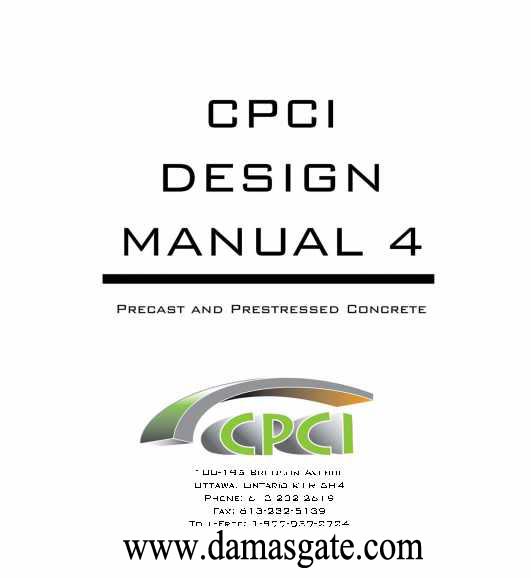CPCI Design Manual - 4th Ed, Canadian Precast & Concrete Institue

CONTENTS
CHAPTER 1 – METHODS AND MATERIALS
CHAPTER 2 – ANALYSIS AND DESIGN OF STRUCTURES
CHAPTER 3 – DESIGN OF ELEMENTS
CHAPTER 4 – DESIGN OF CONNECTIONS
CHAPTER 5 – ARCHITECTURAL PRECAST CONCRETE
CHAPTER 6 – RELATED CONSIDERATIONS
CHAPTER 7 – PRODUCT INFORMATION AND CAPACITY
CHAPTER 8 – GENERAL DESIGN INFORMATION
INDEX
FOREWARD
The Canadian Precast/Prestressed Concrete Institute (CPCI) is a non-profit corporation founded in 1961
for the purpose of advancing the design, manufacture and use of architectural and structural precast
and prestressed concrete throughout Canada.
CPCI represents a fast growing segment of the Canadian construction industry.
The first prestressed concrete structure in Canada was a precast, prestressed concrete bridge erected
in 1952 in North Vancouver. Since then, precast prestressed concrete has been used in buildings and all
types of engineered structures. Structural and architectural, reinforced, pretensioned and post-tensioned,
precast concrete has been successfully and economically utilized in an ever expanding variety of applications.
CPCI developed into a unique trade and professional association, with a representative mix of companies and individuals.
CPCI members include producers (Active Members), suppliers (Associate and Supporting Members), engineers and architects
(Professional Members), plus Affiliate and Student Members.
From the beginning, CPCI established a close working arrangement with the Precast/Prestressed
Concrete Institute (PCI). CPCI continues to enjoy a mutually beneficial relationship with PCI sharing
state of the art information about the industry,
its products and services, that results in combined knowledge, developments and experience.
The focus of CPCI’s current activities includes the design and construction community in Canada in the areas of specifications, codes and standards, liaison with technical schools and universities, awards programs, seminars, trade shows and conventions of owner/user groups.
CPCI continues a liaison with the federal government on behalf of the industry in two principal areas. The Institute assists CPCI members in marketing their products and services to government. Secondly, an important dialogue has been established to provide the government with information about the industry.
CPCI participates with the Cement Association of Canada (CAC) and allied concrete industry members to promote concrete as a safe, fire resistant, sustainable construction material.
The Active Membership in the Institute represents over 75% of the industry's capacity in Canada. CPCI continually disseminates information on design, production practices, field techniques and environmental issues, via national and regional chapter programs and technical publications, all directed towards advancing the state of the art for Canadian owners and designers.
Architects, engineers, owners, developers and contractors are invited to contact CPCI for additional information on the design and construction of precast and prestressed concrete and on membership in CPCI. Please visit: cpci.ca
PREFACE
In 1964, the Canadian Precast/Prestressed Concrete Institute (CPCI) published the first design manual in North America on precast, prestressed concrete. This was a major undertaking for a fledgling industry. This handbook consisted of 4 parts: Part 1 contained the CSA Standard CSA-A135-1962 and a commentary, Part 2 contained design theory and practice, Part 3 dealt extensively with connection design and Part 4 contained sections on specifications and plant standards. The handbook was well received with orders received from around the world.
During the 1970's, the standard design references for precast, prestressed concrete in North America were published by the Prestressed/Prestressed Concrete Institute (PCI) in Chicago. The first edition of the PCI Design Handbook was published in 1971, followed by the second edition in 1978 and a series of new editions including a comprehensive updated sixth edition published in 2004.
The Canadian Government's decision in the mid 70's to adopt Sl metric units and the adoption of limit-states design codes reduced the relevance of PCI publications in Canada. CPCI undertook what was to become the single largest undertaking in its history; the publishing in 1978 of the First Edition of the CPCI Metric Design Manual. This publication, four years in the making, was based on the PCI Design Handbook and the PCI Structural Design of Architectural Precast Concrete Handbook. The manual was written entirely in Sl units with extensive references to Canadian design codes.
In 1984, CPCI published a Second Edition of the CPCI Metric Design Manual. This decision was based upon extensive revisions to CSA Standard A23.3.
The Third Edition of the CPCI Design Manual introduced significant changes in the state of the art for precast, prestressed concrete, plus important changes in A23.3 that recognized the benefits of quality control in certified precast concrete plants.
See page iv for important updates contained in this Fourth Edition.
Download
http://s18.alxa.net/s18/srvs2/01/CPC...e.Institue.rar